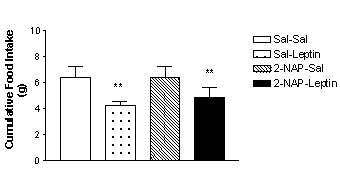| pA2 online © Copyright 2004 The British Pharmacological Society |
130P
GKT, University of London Winter Meeting December 2003 |
|
Does intraperitoneal
administration of leptin suppress food intake by releasing endogenous
cholecystokinin? |
|
We have previously reported that i.p. administration of low microgram doses of leptin produces a short lasting decrease in food intake in hungry rats by a vagally mediated mechanism of action and suggested that leptin released from the stomach during a meal may play a role as a short-term peripheral satiety factor (Patel and Ebenezer, 2001, 2002, 2003). However, it is also possible that leptin may act indirectly to stimulate vagal afferents by releasing the putative satiety factor cholecystokinin (CCK). The present study was undertaken to investigate this possibility.
Male Wistar rats (b. wt. 350 - 420 g) were used in this experiment. The animals were deprived of food for 22h each day prior to each experimental session. Rats in Group A (n=7) received the following treatments: physiological saline (sal) followed by sal, sal followed by CCK (4 µg kg-1), the CCK1 receptor antagonist 2-napthalene-sulphonyl L-aspartyl-(2-phenethyl) amide(2-NAP; see Ebenezer & Baldwin, 1995) (4 mg kg-1) followed by sal, and 2-NAP followed by CCK. Rats in Group B (n=6) received the following treatments: sal followed by sal, sal followed by leptin (25 µg kg-1), 2-NAP (4 mg kg-1) followed by sal, and 2-NAP followed by leptin. All drugs and saline were administered by the i.p. route. A period of 30 min separated the two injections. Immediately after the second injection the rats were placed singly in experimental cages with free access to food and water and food intake measured, as described previously (Ebenezer & Baldwin, 1995). The animals in each group received all treatments in a repeated-measures design and 2 - 3 days separated successive trials. ANOVA was used to analyse the data.
In agreement with previous observations (Ebenezer and Baldwin, 1995), 2-NAP abolished the suppressant effect of CCK on food intake in fasted rats. Thus, at 15 min after presentation of food, CCK significantly (P<0.01) reduced food intake from a mean control value ± s.e. mean of 6.4 ± 0.3g to 1.9 ± 0.3g. Pre-treatment with 2-NAP (4 mg kg-1) abolished the hypophagic effect of CCK (food intake: 5.7 ± 0.5g). 2-NAP had no significant effect on food intake on its own. By contrast, 2-NAP did not reverse the suppressant effect of leptin (25 µg kg-1; i.p.) on food intake (see Fig. 1). The results thus indicate that the reduction in food intake observed after i.p. administration of low microgram doses of leptin in fasted rats is not secondary to the release of endogenous CCK. These finding are consistent with the hypothesis that leptin acts directly on leptin receptors on vagal afferents (Buyse et al., 2001) to signal the brain to produce satiety (Patel & Ebenezer, 2001, 2002, 2003).

Fig 1. The effect of pre-treatment with 2-NAP on leptin-induced hypophagia in rats measured 15 min after presentation of food. Vertical lines represent + s.e.mean **P<0.01
Buyse, M. et al.
(2001) Eur. J. Neurosci., 14, 64 - 72.
Ebenezer, I.S. & Baldwin, B.A. (1995) Br. J. Pharmacol.16,
589-595.
Patel, J.D. & Ebenezer, I.S. (2003) Br. J. Pharmacol. 140,
61P.
Patel, J.D. & Ebenezer, I.S. (2002) Br. J. Pharmacol., 134,
118P.
Patel, J.D. & Ebenezer, I.S. (2001). Pharmacology Vancouver 2001
Abstracts, P1-63.